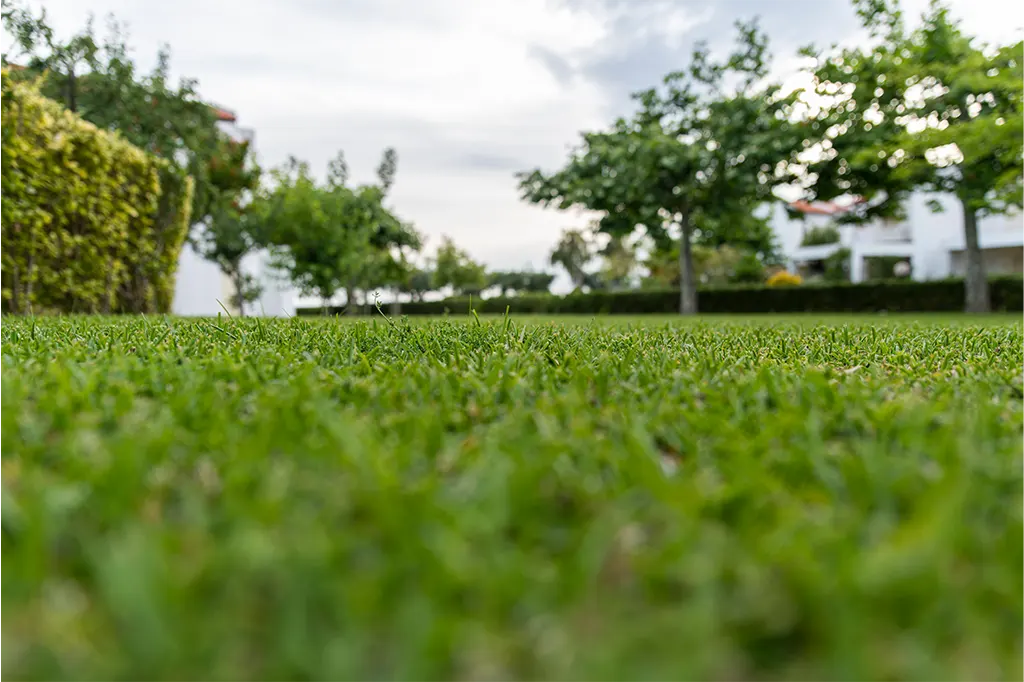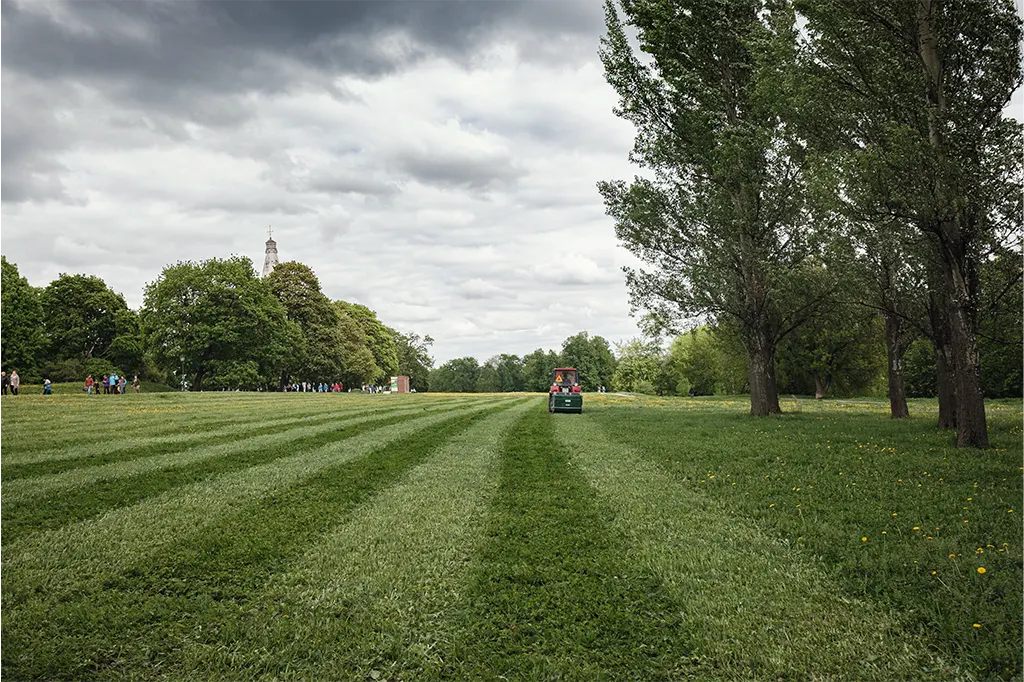
Choosing turf for your yard, sports field, or high-traffic area can feel overwhelming. You may be looking for a beautiful lawn for your home, a putting green, or simply a type of synthetic or natural turf that can withstand heavy use. Regardless, understanding the different types of turf products available to buy is essential. This guide will walk you through everything you need to know, from natural grass varieties to synthetic turf, helping you make the right choice for your property.
Understanding the Difference Between Natural and Synthetic Turf
The first step in choosing turf is deciding whether natural grass or artificial turf is the best fit.
Most people do not think of natural grass when they hear the word ‘turf’ for the first time. Their mind automatically brings them to synthetic grass but it’s natural grass that is often a superior product. Natural grass is known for providing a lush, green lawn that feels soft underfoot and which supports local ecosystems. The most popular varieties include Kentucky bluegrass and cool season grasses. These and other types of natural grass turf are known to thrive in temperate climates and offer a classic, vibrant lawn look.
Comparatively, synthetic turf (or artificial turf) is a non-organic product engineered to mimic natural grass while requiring minimal maintenance. Some turf products come with antimicrobial properties, UV resistance, and customizable pile heights to suit a variety of applications. Despite its advantages, synthetic turf rarely matches the feel or aesthetics of natural grass. In addition, artificial turf is associated with negative environmental effects and, in some cases, can damage easily. If you choose synthetic turf, be careful. While once believed to be highly advantageous, it is rare to see synthetic preferred over natural grass turf.
Key Considerations When Choosing Turf
As you’re selecting between synthetic and natural turf, here are several factors to keep in mind before you make a decision.
1. Purpose and Usage
Consider how your turf area will be used. For a home lawn, your top priorities are likely to be how it looks, softness, and whether it carries a natural feel or not. For sports fields or play areas, durability, drainage, and resistance to wear are more critical considerations. To this later point, this is why organizations such as FIFA require premium matches, including the World Cup, to be played on natural grass turf instead of synthetic.
2. Climate and Temperature
The climate and temperature of your region are a collective factor no turf owner should ignore. Cool season grasses, like Kentucky bluegrass, thrive in temperate climates and are ideal for lawns that experience wider variations in temperature. For unpredictable seasons across Canada, this is the type of turf you want. For regions with hot summers or drought conditions, drought-tolerant grasses are also something to look for and a smart choice.
3. Maintenance Requirements
It’s important to remember that natural grass requires regular lawn maintenance, including mowing, watering, fertilization, and pest control to stay healthy. Homeowners who enjoy lawn care may appreciate the hands-on experience, but it’s important to assess whether you have the time and resources to maintain a beautiful lawn consistently. Some don’t. In their case, synthetic turf may be the way to go despite drawbacks.
4. Soil and Drainage
Should you choose to forego synthetics and opt for natural, good soil quality and drainage are a must for natural grass to thrive. Poor drainage can lead to waterlogged patches, disease, and uneven growth. This is something to monitor and consider as you want a turf that allows water and moisture to flow through and remain functional even in wet conditions.
Exploring Popular Grass Varieties
Many homeowners decide on natural grass turf but there are several types of natural grass to choose from. Knowing the differences between common grass varieties can help you choose the right grass for your lawn:
1. Kentucky Bluegrass
Renowned for its lush, dark green colour and fine texture, Kentucky bluegrass is a top choice for traditional residential lawns. This type of natural turf spreads quickly through underground rhizomes, creating a dense and uniform lawn that will recover well from wear.
2. Fescue Grass
Fescue grasses are another type of natural grass that many homeowners and property owners consider. It is versatile and drought-tolerant, making fescue suitable for areas known to experience variable weather, ranging from hot, dry conditions to overly wet or freezing cold climate. In terms of what you’ll discover in this category, fine fescues are softer and ideal for low-traffic lawns, while tall fescues handle higher foot traffic better.
3. Bermudagrass
Popular in warmer climates, Bermudagrass grows quickly and tolerates heat and heavy use. It’s an excellent option for sports fields and lawns that experience constant activity, though many homes may not necessarily require a grass quite this resilient. For any lawn area where there’s an expectation that it will experience significant use, seek out a strong natural turf choice as anything less could mean faded, damaged appearances over time.
4. Cool Season Grasses
Cool season grasses thrive in regions with mild summers and cold winters which admittedly is not always Canada. Cool season grasses grow actively in spring and fall, maintaining a vibrant green lawn during those periods while requiring some extra care in extreme heat. As long as a property owner is protective of cool season grasses during hot summer weeks, this variety is rather resilient and can last an extended length of time with no issues.

Understanding Synthetic Turf Options
If you’re considering artificial turf, it’s important to understand the features that differentiate this style of turf product as well.
1. Pile Height
The pile height of artificial turf refers to the length of the grass blades. Longer blades provide a more natural look and softer feel, while shorter blades offer easier maintenance and durability for high-traffic areas. In many cases, shorter blades sacrifice aesthetics in an uncomfortable way for some.
2. Density and Infill
Dense turf provides better cushioning as a person walks over artificial turf and supports heavier use, perfect for sports fields and areas where you know that community will gather. Infill materials, such as sand or rubber, are often used to add stability, improve drainage, and help artificial grass stand upright.
3. Antimicrobial Properties
While not a priority for every property owner, some may be searching for antimicrobial turf. Many modern artificial turf products include antimicrobial coatings to prevent bacteria, mold, and odors, making them ideal for play areas, pets, and sports fields.
4. UV and Weather Resistance
Synthetic turf is engineered to battle back against the damage that can come from sunlight, temperature extremes, and heavy rainfall. This means little-to-no fading or deterioration, though some low-quality synthetic turf may still degrade even if they are promoted as UV-resistant. Needless to say, this type of turf makes for a long-lasting pick for both residential and commercial applications.
Matching Turf to Your Space
Choosing turf is as much about aesthetics as it is about selecting a product that fits your environment and lifestyle.
Homeowners often want a beautiful, green lawn that they know will enhance curb appeal and that they’ll be able to enjoy outdoors. In that respect, Kentucky bluegrass or a drought-tolerant fescue blend offers a classic look with manageable maintenance.
Alternatively, there are high-traffic spaces like playgrounds, dog parks and trails, and outdoor entertainment that need turf where the goal is going to be a little different. The turf here must be able to withstand heavy wear. While it can be tempting to search for artificial turf manufactured with dense fibres, tough grass varieties like Bermudagrass or tall fescue perform even better in these conditions.
If we’re discussing something akin to a sports field, athletic areas require turf that is resilient, safe, and consistent. What you choose for turf for sports fields should maintain an even surface, resist damage from cleats, and offer excellent drainage.
Practical Tips for Choosing the Right Turf
- Assess Your Priorities – Consider whether your property is best suited with a turf that is low-maintenance, visually appealing, or durable.
- Test Soil and Light Conditions – Perform a soil test and examine what sun exposure the area has. Some grass varieties thrive in full sun, while others tolerate shade better.
- Evaluate Maintenance Commitment – Be realistic about how much time and effort you can dedicate to lawn care. Natural grass requires ongoing attention to keep it looking its absolute best.
- Consider Costs – Factor in water usage, fertilizers, mowing, and potential turf replacements over the long-term. Turf is an investment that any property owner will want to maintain or risk a degradation of appearance slowly over the seasons.
- Think About Climate – Choose grasses suited to your local climate. This ensures your lawn looks its best year-round.
Choose the Right Turf with Lavington Turf Farms As Your Guide
When it comes down to it, what you decide to use for turf will have to balance aesthetics, practicality, and long-term goals.
A natural lawn is our recommendation, due to its ability to offer unmatched beauty and a sensory experience that a synthetic turf cannot match. That said, it is not without care and attention. With the right maintenance, premium-quality natural turf outperforms synthetics on durability and flexibility. It is often your best choice for areas with a lot of foot traffic, such as sports fields. For any homeowner seeking a worry-free lawn, they can’t go wrong with quality-made natural grass.
Take the time to speak to an expert about grass varieties, what turf products may be best suited to your region, the impact of environmental conditions on turf, and how you should carry out maintenance. Make an informed decision and choose the turf that you know you will be able to enjoy for many, many years to come.Choosing turf doesn’t have to be complicated. Talk to one of our team members at Lavington Turf Farms to discover more about how to figure out what type of turf is best for your property. Contact us today.